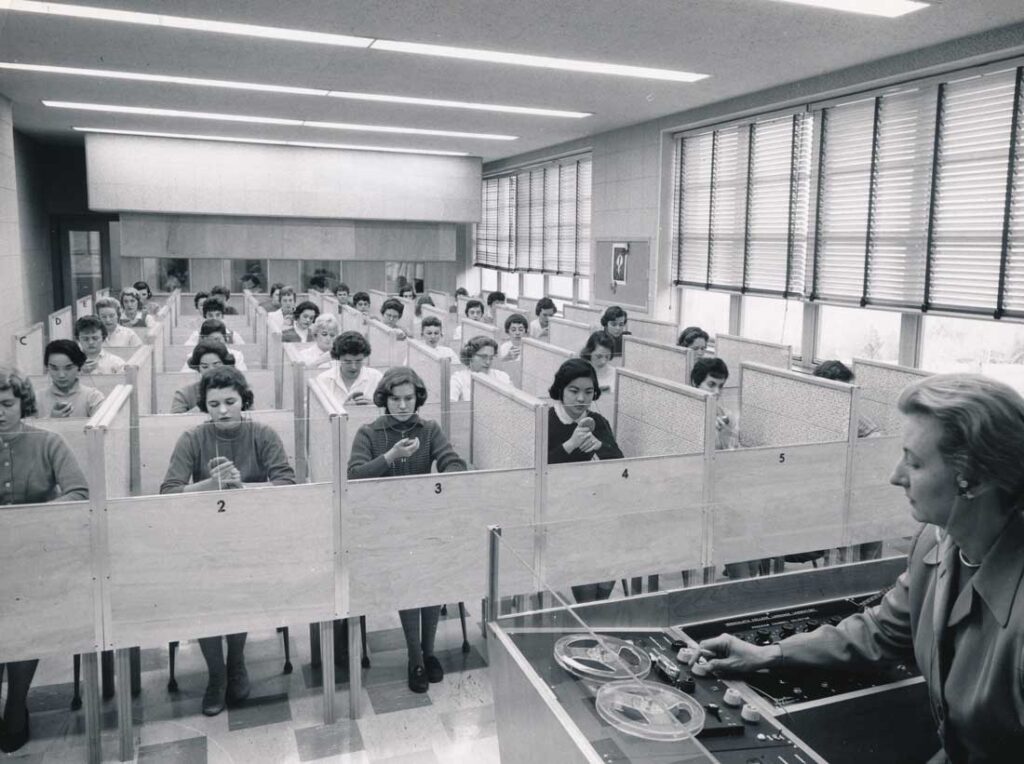
Once upon a time, students used typewriters, then desktop computers in labs and now personal laptops. Professors who once printed lecture notes on plastic sheets for overhead projectors later shifted to PowerPoint slides and now interactive smart boards. Students once had to take turns using the hall pay phone, then they had room phones, and now they have multi-tasking, internet-connected mini computers that send emoji-studded texts. Because who makes phone calls anymore?
“Technology will continue to change, with astonishing speed and with consequences that are difficult to predict, much less prepare for,” according to a July 2019 article in EDUCAUSE Review. Digital transformation, the article says, has the potential for “improved student outcomes, more effective teaching and learning methods, new research capabilities, and an evolution in business models.”
In the 1980s and ’90s, Immaculata’s leaders began to take notice of technology’s potential. Sister Marie Roseanne Bonfini, IHM, Ph.D., points to “pioneers of technology” at Immaculata who purchased the college’s first computer software system in 1982. Sister Roseanne, who was then working in institutional research and planning, received one of only two campus computers, with 69 kilobytes of memory.
She became president of Immaculata in 1992, and when the Gabriele Library opened the next year, “we decided that it was going to be a learning center type of place, and not just a book repository,” she said. Robert and Phyllis Bellopede ’82 donated 25 IBM computers for students to use in the library’s technology center.
Sister Roseanne joined leaders from other local colleges to ask for federal grants, and they received almost $7 million to build infrastructure on their campuses and share resources electronically. Sister M. Carroll Isselmann, IHM, Ed.D., then-vice president for academic affairs, allocated resources and guided the implementation of new technologies.
“By 2002, when I left office, every faculty member had a computer, every student had a telephone in her room, everyone on campus had access to the internet and cable services, and online education was growing,” said Sister Roseanne.
“Remote learning is a great benefit for students,” agrees Bryan Steinberg, Ed.D., IU’s executive director of technology services. Technology used to be a “nice-to-have,” he says. “But now, it’s really interwoven into businesses and processes. It’s more like it’s a requirement.”
To prepare for the workplace, IU’s business and fashion merchandising majors have technology integrated into their learning experiences, including using software made by technology giant SAP. Having exposure to SAP’s systems gives graduates an edge in the job market.
Giving examples of automation that range from document management to self-driving cars, Steinberg asks, “Does that make us more efficient and smarter, or does that hamper us in the future?” Fast food kiosks may make the process of ordering a meal more efficient. But personally, Steinberg says, “I prefer to have the human element…I like the interaction.”
Some of Immaculata’s IT systems facilitate interpersonal interaction. Student support staff use Starfish, a program that allows them to see students’ academic performance and early alerts that identify students who may need extra help. Faculty share information about students with appropriate support staff, send kudos for good grades or refer students who show signs of struggling.
“If you invest in the right technology,” Steinberg says, “you can aid in somebody’s growth.”